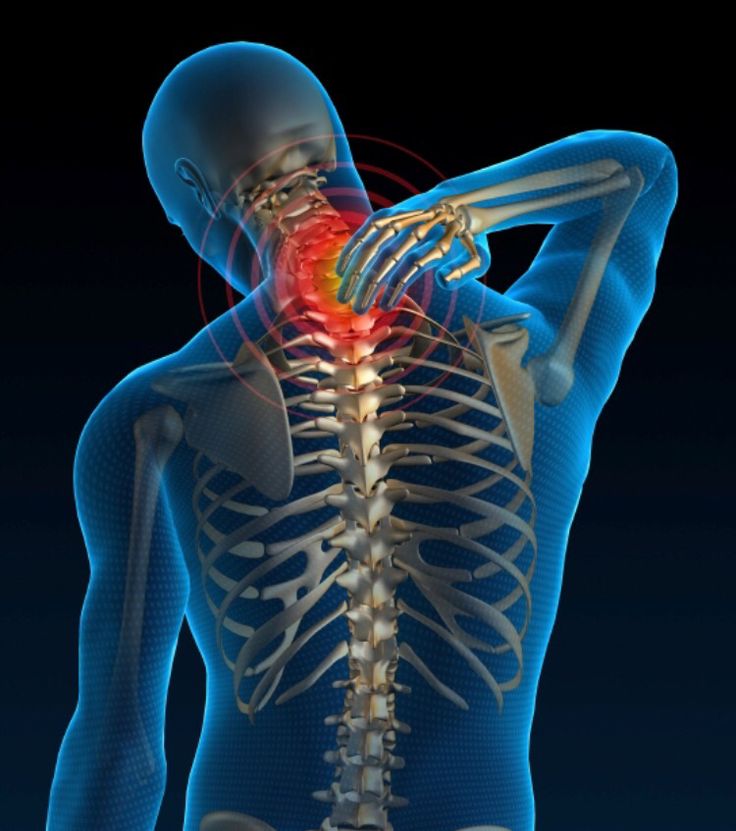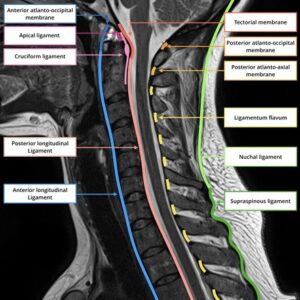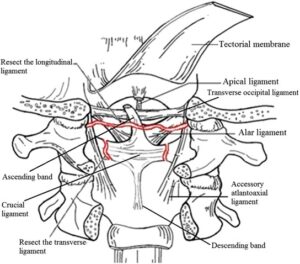

If you are keen on learning about the three ligaments in my neck that were damaged by my forward head posture then, you have got read this article carefully.
It is always good to know the adverse side effects of a bad neck posture. If you are unable to fix your neck posture, it I highly likely that you shall continue to suffer for the rest of your life.
I suffered from aches and pains in and around the neck area. At the same time, I also suffered from muscle stiffness in the upper area of the back.
While I was researching how to fix my nerd neck, I realized the damage my forward neck had done to the ligaments of my neck.
Here is a quick look at the ligaments that took the brunt of the damage:
Three Ligaments in My Neck that were Damaged by My Forward Head Posture Article Contents:
1) A Brief on My Forward Neck Posture
2) What is so Special about My Cervical Spine?
3) What are the Main Functions of My Neck Ligaments?
4) Which 3 Ligaments Bore the Brunt of My Bad Neck Posture?
5) FAQs on Bad Neck Posture & Ligament Damage
6) What is My Suggestion to People with Forward Neck?
A Brief on My Forward Neck Posture
Forward neck posture is described as a physical condition wherein the head is pushing itself a few inches in front of its natural position. Simply put, if my head is sliding ahead of my cervical spine, I have a nerd neck.
Even better – if the lobes of both my ears are not in sync with my shoulders then, I have a crane neck posture. The unnatural “hunch”, “slide” or “shift” of the head forwards, is termed as a forward neck posture.
In my case, my head was always sliding 2 to 3 inches ahead of my cervical spine. My ear lobes were ahead of my shoulders and my chin was always “poking” forwards.
Side Effects of My Bad Neck Posture:
@ My bad neck was adding 40 to 60 pounds of added weight onto my cervical spine.
@ This weight placed added unwanted strain onto my rear neck muscles. They were shortened and scarred.
@ The muscles of my upper and lower back were stressed owing to my weakened neck muscles.
@ The joints of my upper back started to stiffen owing to my forward neck.
@ Finally, the muscles located on the front portion of my neck were spared of any work. So, my neck muscles became weak and lost their ability to tuck my chin. The end result of – a “poking” chin.
@ Aches and pains in the neck and upper back became constant. I was simply sick and tired of them.
So, what Caused my Forward Neck?
I believe it was my job. Nonetheless, I do not wish to blame my job for it. While I did have to sit in front of the computer screen for hours, I could have opted for a better chair or a ergonomic computer desk.
Doing so may have helped me adjust my head optimally while I worked on my computer.
Moreover, I sat for hours at length. This further placed unwanted stress on my neck muscles and ligaments.
I could have gotten up from my chair after every 15 minutes and taken a 2 minute break. Walking up and down for 2 minutes may have reduced the strain paced onto my neck, head and shoulders.
What is so Special about My Cervical Spine?
Well, the specialty of my cervical spine is its ability to hold my neck in place. When my neck is in place, my head is automatically in place. My spine (just like yours) contains 7 layers of bones.
My Vertebrae:
These bones (also known as vertebras) are placed one above the other. These are labeled C1 to C7. So, it’s like, C1, C2, C3, C4, C5, C6 and finally C7.
The Atlas:
The C1 vertebrae is also known as the “Atlas”. It is shaped different and it tends to support my head.
My C1 vertebrae is shaped like a ring. On this ring rests my head.
So, if I am looking for an optimal head movement then, my C1 vertebrae needs to be in perfect condition and shape.
My Axis:
Right underneath lies the C2 vertebrae. It is also termed as the “Axis”.
C1 vertebrae helps shift my head from the left to the right and vice versa.
In a nutshell, the Axis and Atlas tend to support my head movement in an optimal manner.
Role of My Facet Joints:
The facet joints are what connect one vertebrae to the other. So, the C1 and the C2 are joined together via the facet joints. The other vertebras too are joined via the aid of facet joints.
The facet joints allow me to twist my head and shift it forward/backwards with ease. They instruct the C1 to C7 vertebras to follow my head/neck movement in a seamless fashion.
My Shock Absorbers:
So, what keeps my vertebras from slamming against each other?
The ligaments and tendons are what act as shock absorbers. Along with the muscles and nerves, the ligaments in my neck tend to act as cushions to my vertebras.
The intervertebral discs are the “ultimate layers of cushion” that are positioned between each vertebrae. Without the intervertebral discs, my vertebras shall slide and grind against one another.
The Messenger:
Apart from resting my neck and head in an appropriate manner, the spinal cord also acts as a messenger. It receives the messages dispatched by my brain.
The spinal cord starts from the head and runs all the way down to my spinal column. So, all the functional necessary to keep me active are therefore a handiwork of my spinal column.
What are the Main Functions of My Neck Ligaments?
I have discussed my bad neck posture in my above paragraphs. The reasons behind the same have also been discussed.
Nonetheless, in this article, I shall throw light on the three ligaments present within my neck that were damaged the most. All this happened owing to my forward neck.
What are My Ligaments Used For?
Did you know that my body (just like yours) has 900 ligaments?
These are vital as they keep my organs and bones connected with one another. Without the presence of ligaments, my bone, organs and my joints shall not remain in their present state.
In the neck, there are 3 ligaments that can be considered important. It is not very easy to tear or rupture ligament. Nonetheless, it can happen owing to overstraining of the ligament.
These ligaments comprise of connective tissues, collagen as well as fibers. These fibers have the natural ability to be stretched. So, they can be termed elastic.
Functions of My Neck Ligaments:
@ The first major function of my ligaments in the neck is to hold the neck bone or the cervical spine in place.
@ These ligaments also allow my neck to rotate, shift sideward, move backwards/forwards seamlessly.
@ Any joint in my neck bone (such as the one between C1 and C2) is allowed to shift seamlessly. Any unwanted twisting and bending is completely avoided here.
@ The ligaments in my neck also stabilize my spinal column. My C1 to C7 vertebrae are able to remain at their designated spot via these ligaments.
@ The joints in my spinal cord are also held in place via the ligaments.
@ Finally, the bones of my spinal cord remain intact because of the ligaments holding them in place. So, the chances of dislocation are avoided.
Which 3 Ligaments Bore the Brunt of My Bad Neck Posture?
My crane neck posture had a major role to play in stretching my neck ligaments. The constant stress added to these ligaments caused unwanted aches and pains in my neck area.
Apparently, the added weight to my spine (over 40 pounds) caused my ligaments to stretch. My neck muscles were also damaged my neck muscles.
I believe they were slightly torn as well. So, swelling and stiffness in the upper back and neck were evident.
A quick look at the three neck ligaments that took the beating:
Ligamentum Flavum:
The first ligament that was affected adversely was Ligamentum Flavum. This ligament is yellow in color. It tends to initiate from the inferior border of the lamina and runs all the way down to its superior edge.
Where is it Located?
In simpler words, each vertebra is lined with this ligament. The opening of C1 to C7 vertebra are stapled from the inside by Ligamentum Flavum. This ligament protects the rear end of my cervical spine.
What is its Function?
The main function of Ligamentum Flavum is to help me maintain an upright posture. This in turn implies that I can hold my head and my neck upright only if my Ligamentum Flavum is in perfect order.
The Tear and Stretch:
As I was always sliding my head forward, the Ligamentum Flavum stretched. This was not an overnight stretch. It took years of my bad neck posture to stretch this ligament.
The Result:
I was unable to maintain the optimal curvature of my spine. It forced my neck to buckle a lot. In fact, I felt there was an issue with my head’s hypertrophy.
My lumbar canal started to narrow down. In fact, my thoracic canal also started to shrink in size. It was all owing to my bad neck posture that made my Ligamentum Flavum ligament hypertrophic.
Anterior Longitudinal Ligament:
The second ligament that was adversely affected by my vulture neck posture was my Anterior Longitudinal Ligament. The tear and stretch to this ligament was owing to my forward neck posture.
Where is it Located?
It stretches from the base of the skull and covers my cervical vertebra from the front side.
This ligament covers the intervertebral discs. It is narrow when it covers the vertebral bodies and thickens when it binds with the intervertebral disc.
What is its Function?
The function of the Anterior Longitudinal Ligament is to provide stability to my spine.
It also helps in reinforcing the strength of the vertebral discs by avoiding over-extension of the vertebral column.
The Tear and Stretch:
So, in my case, the constant stress laid on my spine owing to my forward head caused the Anterior Longitudinal Ligament to hyperextend.
The Result:
This in turn forced my spine to destabilize. In fact, my intervertebral discs too became feeble. Stiffness and pain, thus became a part and parcel of my life.
I was told by the doctors that I suffered a whiplash injury owing to a stretched Anterior Longitudinal Ligament. Loss of flexibility was also a direct resultant of this damaged ligament.
Posterior Longitudinal Ligament:
The third and final ligament that was damaged owing to my poor neck posture was the Posterior Longitudinal Ligament. In total, three ligaments were damaged because of my nerd neck.
Where is it Located?
The Posterior Longitudinal Ligament is a smooth fiber like structure that connects all the posterior vertebrae of my neck. It is thick in the thoracic region and narrower in the lumber regions.
The Posterior Longitudinal Ligament has serrated edges. It smoothly covers my basivertebral veins and also encompasses my intervertebral discs.
What is its Function?
Posterior Longitudinal Ligament is responsible for limiting the hyperflexion process of my vertebral column.
This ligament also assists in limiting herniation of my spinal disc.
The Tear and Stretch:
Just like in the above two ligaments, the Posterior Longitudinal Ligament also tore.
It was all the doing of a forward head that I had been carrying for the past 4 to 5 years.
The Result:
As the Posterior Longitudinal Ligament has lots of nociceptors, they caused me a lot of back pain.
The only good part was a speedy recovery owing to increased blood flow.
This was owing to the high levels of vasomotor fibers naturally present in my Posterior Longitudinal Ligament.
FAQs on Bad Neck Posture & Ligament Damage
Q-1: Which three ligaments in the neck are most commonly damaged by forward head posture?
A-1: The anterior longitudinal ligament, the ligamentum flavum, and the posterior longitudinal ligament are frequently affected by forward head posture. These ligaments help stabilize the cervical spine and are strained when the head consistently projects forward.
Q-2: How does forward head posture cause damage to the anterior longitudinal ligament?
A-2: This ligament runs along the front of the cervical vertebrae and limits excessive backward movement. Forward head posture places abnormal tension on it as the neck compensates for the head’s misalignment, potentially leading to microtears and inflammation.
Q-3: What impact does forward head posture have on the ligamentum flavum?
A-3: The ligamentum flavum connects the vertebrae at the back of the spinal canal and maintains spinal stability. According to bestforwardheadposturefix.com, “Chronic forward positioning of the head can cause this ligament to thicken or lose elasticity, which may contribute to nerve compression and neck stiffness”.
Q-4: Why is the posterior longitudinal ligament vulnerable in forward head posture?
A-4: Located inside the spinal canal along the back of the vertebral bodies, the posterior longitudinal ligament resists excessive forward bending of the neck. Forward head posture increases strain on this ligament, which can lead to wear and tear, contributing to spinal instability and discomfort.
Understanding these ligament issues highlights the importance of correcting forward head posture early to prevent long-term cervical spine damage and maintain neck stability and function.
What is My Suggestion to People with a Forward Neck?
Forward neck is a posture related issue. I believe in the current scenario, most adults suffer from bad neck posture. This is owing to the unhealthy lifestyle that we are made to lead.
Working for long hours on the computer and watching the cellphone are 2 of the many bad habits that lead to forward head. The added weight to the spinal column is so severe that it takes a toll on your ligaments.
So, I would suggest that you promote good neck posture. Make an effort to maintain optimal spinal posture. Also, learn the correct yoga exercises to fix your poor neck posture.
References:

